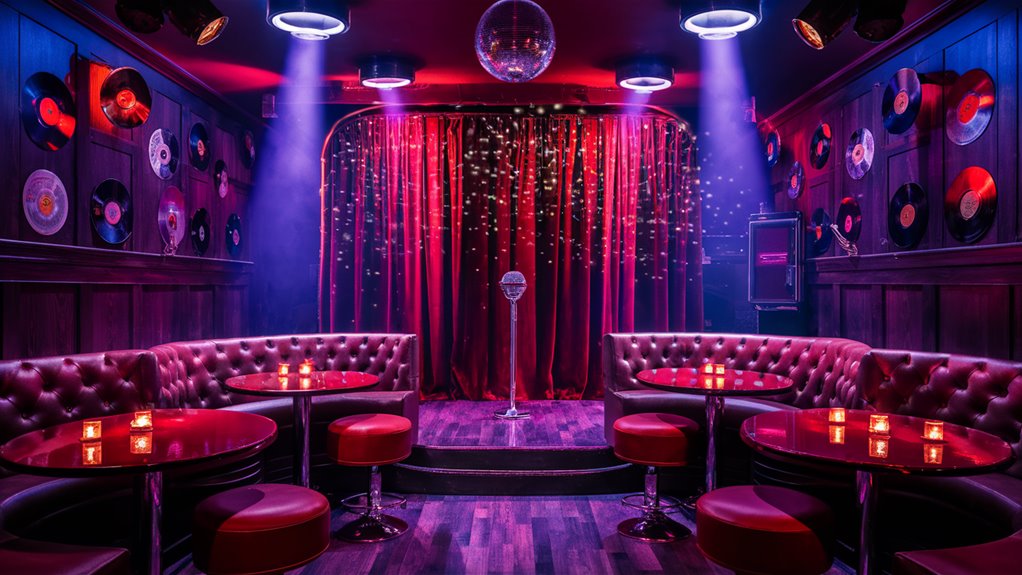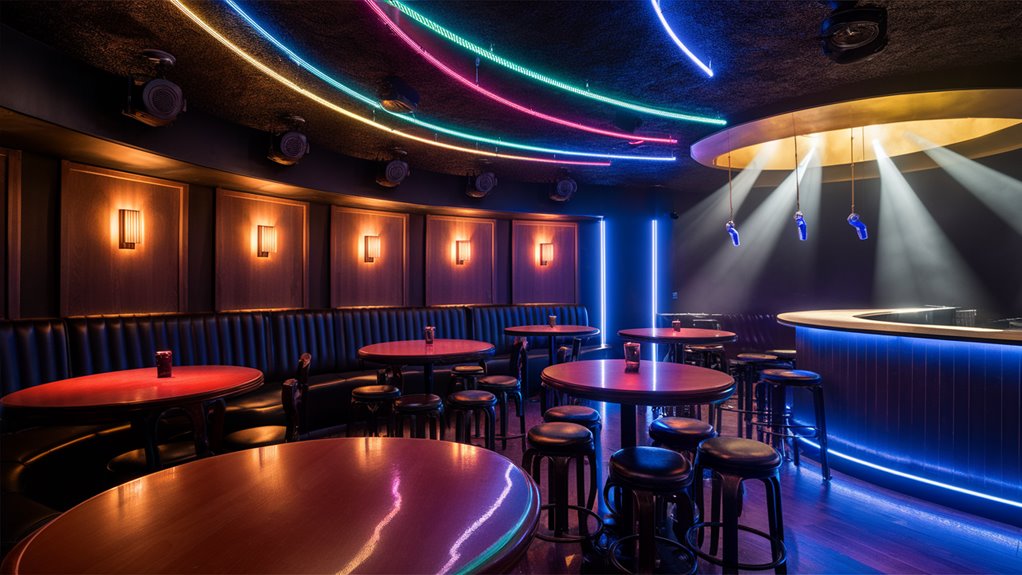How to Make the Best Karaoke Bar: A Full Guide

Key Lights and Stage Setup
A top karaoke spot begins with a well-made stage area. Use two main lights and colorful lights to set fun light shows that help the singer feel sure. Smart speaker setup makes the sound clear all around, making it good for both those who sing and those who watch.
Chairs and Coziness
Change up the room with smart chair plans, using U-shaped booth setups to see the stage well and to help people talk. Soft velvet seats are for two jobs – they soak up sound and feel soft to sit on. Put in comfy chairs with built-in places for sound setup drinks to keep drinks safe and avoid spills.
Lights for the Mood
Get good at setting the mood with lights you can dim and deep red and blue lights. These chosen shades make a close feel that starts singing but keeps enough light to read menus and move around safely. Changeable light shows adapt smoothly through the night, matching the energy of your crowd.
Sound Skills
Buy top-level sound gear and check it often to keep sound quality high. Place sound panels smartly to stop echo and make voices clear. Caring for these sound details lifts your karaoke time, giving your spot a lead over others and making sure your guests are happy.
How to Set Up Lights for Karaoke Bars
Needed Lights
Smart lights are key for top karaoke places, shaping how guests feel and sing. Multi-layer light setups set the right mood with adjustable bright lights giving off a gentle glow. Spot lights set right to show key spots and set the mood while keeping the space defined.
Stage for Shows
Colorful stage lights that match the beat make a pro show space. Place show lights at just right angles to cut face shadows and better singer looks. Lights that change color under counters set a smooth mood change matching the night’s energy.
Safe and Private Spaces
Lighting that meets safety ensures clear paths while keeping the mood. Private singing rooms have own light choices with dimmers and fun light panels, letting each group pick their mood. Smart mirrors make light go further and make the place feel bigger, making a fun, balanced space that mixes performance needs and social vibes.
Guide for Setting Sound in Karaoke Spots
Main Speakers
Placing speakers right is key for good sound in karaoke spots. Place four big speakers at smart angles from the stage to lessen unwanted noise. Hang speakers at head height (7-8 feet) with a small tilt down for the best sound area.
Advanced Sound Parts
Digital tools for sound and systems to stop feedback lay the base for top karaoke sound. Put the sound control desk central with a good view of both singers and the crowd. Add extra speakers halfway through the space to keep sound even all over.
Sound Bettering and Backup Systems
Panels to tune sound put in smart spots greatly better voice clearness and cut unwanted echo. Set monitors for singers to keep voice and time right. Have a second sound path ready as a backup to stop breaks in sound. Place bass speakers to spread deep sound even without mixing up main voice sounds.
How to Arrange Rooms and Chairs in Karaoke Bars
Zones That Work
A great karaoke spot needs a clear setup with set zones for each need. The design should have a space just for shows, a bar area, and group spots to sit. Each part has a job but fits well with the whole place.
Spot for Shows
A raised spot or set show area needs the best spot with 90% people able to see. The best plan has a U-shaped chair setup around the center, using tall tables, big booth seats, and big shared tables.
How to Use the Space Well
Smart space use follows these parts: 40% for shows and watching, 35% for seats, 25% for the bar and paths. Key design parts are clear paths between main areas, smart panels for sound, small tables near stage for a couple people, and seats that change for different size groups. The layout must put comfort for the crowd first while making the most of space and keeping good flow. Sound soaking decor should mix in well with the style and manage sound well between areas.
All You Need to Know for Karaoke Stage and Show Space

Pro Stage Plan
A top karaoke place needs a well thought out show space that mixes being seen well with being easy to reach. A raised area, about 12-18 inches high, makes sure of good views but is still easy to step onto. The best stage size has at least 8 feet back and 12 feet across, fitting both one or groups singing.
Light Setup That Works
Pro stage lights should have both fixed and moving parts. Needed parts include: two main lights for clear light, colorful LED lights for fun effects, smart back lights for depth and comfort for the singer.
Sound and Vision Parts
Monitor setup is key for how well performances go. Main parts include: a monitor right in front of the singer, two side speakers for full sound, a main screen at eye level, 10-12 feet from stage, extra screens set around for the crowd.
Think Safety
Safety on stage must have: non-slip strips on all steps, LED markers along stage sides, enough space around the show area, safe hangs for all lights. These parts make a pro show space that looks at both show style and safety, making sure of the best time for both singers and watchers.
Smart Bar Spots & Moving Plans for Karaoke Bars
Best Bar Place for More Money
The smart spot for your main bar is key to making money in a karaoke spot. Put your main bar on the long wall, across from the stage, to have the best view and keep foot traffic smooth. Needed space parts include: at least 4 feet for standing at the bar, 6 feet between bar and chairs, railings for drinks along busy paths.
Other Service Spots & How to Move
Extra Service Areas
Set up extra service spots at far ends of the place to cut down on main bar crowds, handle simple drink orders, make service faster, and cut wait times.
Where to Put Sales Points
Place sales machines at bar ends, not the middle, to make bar work flow better, stop groups from forming, and speed up service.
Best Ways to Move
Key Path Design
Keep paths clear between the main door, stage, restrooms, bar spots, and exit ways in case of emergency.
Stop Crowds
Put in rails for drinks to lessen walk traffic, set up spots for quick drinks, make guests comfy, and make moving around better.
Top Tech for Picking Songs and Showing Them in Karaoke Bars
New Ways to Pick Songs
Screens you can touch change how karaoke spots run with more see easy ways to pick songs. Modern spots let guests look for songs by singer, song name, type, and language. Keeping the song list current on all devices helps manage the queue well and shows wait times right.
Two-Screen Setups
Pro karaoke systems make shows better with smart two-screen setups. The singer’s screen shows clear words and right timing, while the crowd’s screen shows good music videos and song details. Advanced systems let you change pitch, speed, and key to help with singing.
How to Manage the Queue
Song systems make running a venue smooth with smart queue tech. Needed features include: real-time tracking of requests, optimized order of singers, handling special needs, fitting many formats (MP3, MP4, CDG), backup systems ready to go. Frequent updates to the song list keep things relevant by adding new hits and classic ones, while strong plan B tech keeps things going smooth at busy times.
Design and Decor for Karaoke Spots
Lighting and Feel
Modern karaoke places mix new tech with picked design parts to set a fun space. Smart light design uses many layers, including LED strips, designer hanging lights, and wall lights that dim with the music and fit the night’s mood.
Textures and Stuff Used
High-end room design looks at many senses through smart stuff picks. Finishes of high quality include: sound-soaking velvet seats, sound panels that look like wall art, smart use of mirrors to make the space feel bigger, music-themed decor with old records, custom lights showing song words.
Colors and How It Works
Fancy karaoke spots win from a smart color plan focusing on deep, rich shades: deep red, bold blue, rich green. These shades create a look that’s great for photos but still classy. Needed working parts include: comfy small tables, built-in drink spots, set photo spots with good lights, stage focused on shows with top lights, soft backdrops that work with digital screens.
